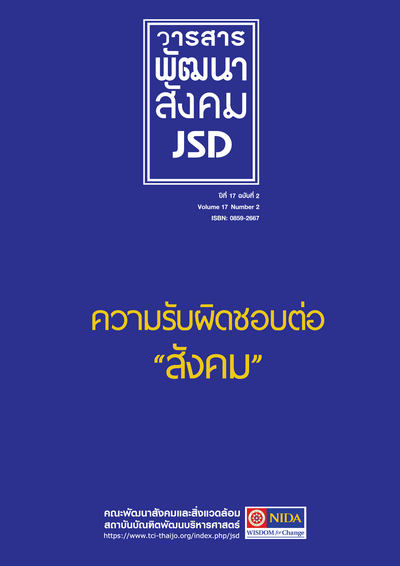ความรู้ภาคปฏิบัติและบทเรียนกับการขับเคลื่อนเชิงนโยบายเพื่อเพิ่มพื้นที่การปลูกพืชร่วมยาง
Main Article Content
Abstract
บทคัดย่อ
บทความวิจัยนำเสนอความรู้ บทเรียนการปลูกพืชร่วมยาง ข้อเสนอแนะเชิงนโยบายในการขับเคลื่อนการปลูกพืชร่วมยางให้เป็นจริงในอนาคต พื้นที่ศึกษาคือตำบลเขาพระ อำเภอรัตภูมิ จังหวัดสงขลา และตำบลตะโหมด อำเภอตะโหมด จังหวัดพัทลุง โดยสัมภาษณ์เชิงลึกบุคคลผู้ให้ข้อมูลหลัก
23 ราย จัดเวทีนำเสนอผลการศึกษา 2 ครั้ง และเวทีสัมมนาทางวิชาการ 1 ครั้ง ผลการศึกษาพบว่าทั้ง 2 พื้นที่มีพืชร่วมยางอย่างเป็นรูปธรรมมากที่สุดของภาคใต้ซึ่งส่วนใหญ่ทำสวนยางเชิงเดี่ยว และเกษตรกรที่ปลูกพืชร่วมยางเกิดจากการขับเคลื่อนของภาคประชาชนเองเป็นหลัก ประเด็นความรู้ภาคปฏิบัติพืชร่วมยาง พบว่าไม้ป่าทุกชนิดปลูกเป็นพืชร่วมยางได้ เช่น ตะเคียนทอง จำปาทอง กฤษณา พะยอม สักทอง เป็นต้น ไม้เศรษฐกิจโตเร็ว เช่น สะเดาเทียม และมะฮอกกานี ไม่ควรปลูกจำนวนมาก ส่วนไม้ผลที่เป็นพืชร่วมยางได้ผลดี ได้แก่ ทุเรียน จำปะดะ กระท้อน มะไฟ รวมทั้ง สะตอ เหรียง โดยควรปลูกพืชร่วมระหว่างร่องยาง ด้วยความหนาแน่น 30-40 ต้นต่อไร่ บทเรียนพืชร่วมยาง พบว่าไม้เศรษฐกิจโตเร็วจะส่งผลชิงลบต่อผลผลิตยาง ไม้ผลที่ไม่เหมาะสม เช่น ส้มโอ ลองกอง มังคุด (ในสภาพดินที่แห้ง) มะม่วง เงาะ แม้ภาคประชาชนมีบทบาทสำคัญในการขับเคลื่อนการปลูกพืชร่วมยาง แต่หากจะให้พื้นที่ปลูกพืชร่วมยางขยายตัวมากขึ้น จำเป็นต้องขับเคลื่อนในเชิงนโยบาย
คำสำคัญ: พืชร่วมยาง ระบบพืชร่วมยาง ความรู้ บทเรียน การขับเคลื่อนเชิงนโยบาย
Abstract
This article aimed to present practical knowledge and lessons learned from practicing the rubber-based intercropping systems (RBIS), including policy implications in expanding the RBIS areas in the future. Kaopra, Rattaphum district, Sonkhla province and Tamod, Tamod district, Patalung province were purposively selected as the study areas. In-depth interviews of 23 key informants were conducted to collect the data. Two academic forums and one seminar were held. The results revealed that almost of the rubber growers, in which the RBIS was driven, still practiced the rubber monocropping system. Additionally, the RBIS was mainly driven by the local people. Regarding practical knowledge from the RBIS practice, all kinds of forest trees, such as Iron Wood, Champak , Eagle Wood, White Meranti and Teak were practically suitable to be rubber-based intercrops. Whereas, fast growing trees, such as mega neem and Mahogany were not practically suitable. Certain kinds of fruit trees, such as Durian, Champedak, Santol, Lantern trees, including Pakria and Nitta trees were cash crops possible to be rubber-based intercrops. The suitable number of these intercrop trees should be 30-40 trees per rai. One important lesson learned from the RBIS practice was that fast growing trees had negative impacts to the production of rubber. Fruit trees such as Pummelo, Longkong and Mangosteen (in dry areas), Mango, Rambutan and Longan were unsuitable. Although the local people had been playing an important role for the RBIS practice in the study areas, the RBIS could be perceived much wider if it was driven by certain policy forces.
Keywords: Rubber-based Intercrops, Rubber-Based Intercropping Systems (RBIS), Practical knowledge, Policy driven forces


